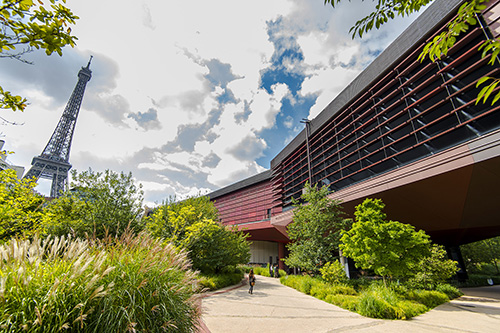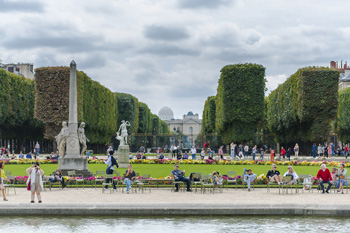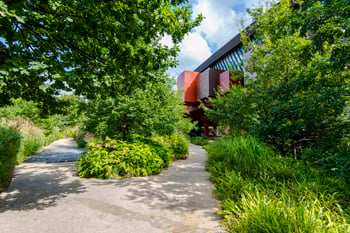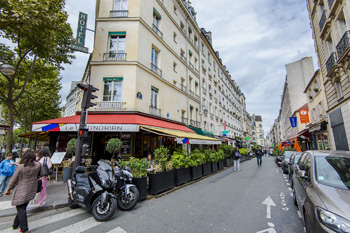Paris: A Study in the Value of Public Green Spaces
Fri, Sep 26, 2014 Albert Lam Public Green Space, Landscape Architecture, Parklets, Green Urban Spaces, Albert Lam, urban development, Heat Island Effect
 Part 1 of 2
Part 1 of 2
I really enjoy traveling because it allows a glimpse into different cultures and ways of life and broadens my view on how people and things function. I just returned from a trip to Europe for the first time since my vacation five years ago, and the journey has certainly been eye opening.
My first stop was Paris, and exploring the city through the lens of my experience practicing architecture yielded some thoughtful observations in urban development and sustainable measures. Among them, I was particularly struck by the abundance of green spaces throughout the city and how the Parisians used them.
 Anyone practicing sustainable architecture knows the value that green sites provide for a project. Landscape complements the building, softens the urban space, improves the atmosphere through air filtering and reduction of heat island effect, and provides welcome gathering areas for people to enjoy. Paris definitely provided plenty of examples of this.
Anyone practicing sustainable architecture knows the value that green sites provide for a project. Landscape complements the building, softens the urban space, improves the atmosphere through air filtering and reduction of heat island effect, and provides welcome gathering areas for people to enjoy. Paris definitely provided plenty of examples of this.
The Luxembourg Gardens is one of several large parks in the city that are open to the public. This lovely park space has a little bit of everything—from large fountains to verdant botanical gardens, to inviting lawns and fun playground spaces. On any given day, one will find people lying on lounge chairs enjoying the sun, or picnicking between the trees on the grass, or playing on the sport parks. It's a lively, engaging park right in the middle of the city and an absolute joy to explore.
 Landscape also interacts directly with buildings in Paris. At the Musée du Quai Branly, a wonderful garden space begins at the street edge and traces its way to and under the actual building. Like the Luxembourg Gardens, this area is also open to the public for free (paid admission only applies to entering the museum building itself) and offers a lovely public green space as an amenity to the public. The criss-crossing garden paths lend an exploratory ambiance for guests, bringing nature into the urban fabric, and the viewlines of nearby icons like the Eiffel Tower add to the beauty of the space.
Landscape also interacts directly with buildings in Paris. At the Musée du Quai Branly, a wonderful garden space begins at the street edge and traces its way to and under the actual building. Like the Luxembourg Gardens, this area is also open to the public for free (paid admission only applies to entering the museum building itself) and offers a lovely public green space as an amenity to the public. The criss-crossing garden paths lend an exploratory ambiance for guests, bringing nature into the urban fabric, and the viewlines of nearby icons like the Eiffel Tower add to the beauty of the space.
 Even at the street scale, I found examples of greenery integrated into the built environment. Often, it was wide, tree-lined sidewalks that invited pedestrian access and provided welcome shade. These areas brought park space out of confined zones and into regularly trafficked corridors. Sometimes, I would find low barriers with plantlife incorporated into them located next to cafes, cordoning off an outdoor dining terrace from the actual street. These spots reminded me of the "parklets" that have had some popularity in recent years, but in Europe, that's just called part of the sidewalk; no special name needed.
Even at the street scale, I found examples of greenery integrated into the built environment. Often, it was wide, tree-lined sidewalks that invited pedestrian access and provided welcome shade. These areas brought park space out of confined zones and into regularly trafficked corridors. Sometimes, I would find low barriers with plantlife incorporated into them located next to cafes, cordoning off an outdoor dining terrace from the actual street. These spots reminded me of the "parklets" that have had some popularity in recent years, but in Europe, that's just called part of the sidewalk; no special name needed.
What is noteworthy about these spaces is how naturally they occur, because they have been an inherent part of the city fabric for many, many years. Greening an old city like Paris isn't part of some new urban trend; it's how planning has operated for centuries. The results speak for themselves: these areas are vibrant, popular, and relaxing, and they in turn activate the areas around them, resulting in further use and growth.
It's a good model to use for sustainable sites, especially since today's green movement seems to have revealed that timeless ways of doing things are often better strategies than more recent advances.
Albert Lam is a Project Coordinator at California-based LPA Inc. He is a LEED accredited professional who specializes in the design and implementation of K-12 schools. Images courtesy of Albert Lam.
